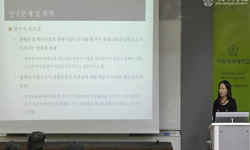범죄 피해는 아동 · 청소년들의 성장 및 발달에 여러 측면에서 부정적인 영향을 미친다. 피해자화에 관한 이론들은 왜 어떤 사람들은 다른 사람들에 비해 범죄 피해를 당할 가능성이 높은가...
http://chineseinput.net/에서 pinyin(병음)방식으로 중국어를 변환할 수 있습니다.
변환된 중국어를 복사하여 사용하시면 됩니다.
- 中文 을 입력하시려면 zhongwen을 입력하시고 space를누르시면됩니다.
- 北京 을 입력하시려면 beijing을 입력하시고 space를 누르시면 됩니다.

범죄 피해 요인의 연령집단별 차이 = The Differences of Victimization by Age Groups: A Comparison of Elementary, Middle, and High School Students
한글로보기https://www.riss.kr/link?id=A108609431
- 저자
- 발행기관
- 학술지명
- 권호사항
-
발행연도
2023
-
작성언어
-
-
주제어
피해자화 ; 연령 ; 피해자-가해자 중첩 ; 자아 통제력 ; 부모 애착 ; 비행 친구 ; 일탈적 생활양식 ; 비행 ; Victimization ; Age ; Victim-Offender Overlap ; Self-Control ; Parental Attachment ; Delinquent Peers ; Deviant Lifestyle ; Delinquency
-
KDC
300
-
등재정보
KCI등재
-
자료형태
학술저널
-
수록면
123-142(20쪽)
- DOI식별코드
- 제공처
-
0
상세조회 -
0
다운로드
부가정보
국문 초록 (Abstract)
범죄 피해는 아동 · 청소년들의 성장 및 발달에 여러 측면에서 부정적인 영향을 미친다. 피해자화에 관한 이론들은 왜 어떤 사람들은 다른 사람들에 비해 범죄 피해를 당할 가능성이 높은가에 대해서 파악하고자 한다. 피해자와 가해자의 중첩의 시각은 피해자와 가해자는 사회인구학적 특성, 개인적 성향, 문화적, 상황적 요인들이 유사하다고 제시한다. 연령은 아동 · 청소년기 피해자화를 설명하는데 중요한 요인이 된다. 그러나 아동 · 청소년기 범죄 피해에 관한 연령의 효과나 연령별 차이점에 관한 연구는 상대적으로 부족하였다. 이와 같은 논의를 바탕으로 이 연구는 아동 · 청소년기 연령에 따른 범죄 피해 요인의 차이점을 고찰하고자 한다. 이 연구는 다음과 같은 가정을 하였다. 아동·청소년들의 연령에 따른 범죄 피해 분포와 비행 분포는 유사성이 있을 것이다. 성별, 학년(연령), 자아 통제력, 부모 애착, 비행 친구, 일탈적 생활양식, 비행은 범죄 피해에 영향을 주는 요인이 될 것이다. 아동 · 청소년들의 범죄 피해의 요인들은 초등학생, 중학생, 고등학생에 따라 차이가 있을 것이다. 아동 · 청소년 범죄피해조사 2017 자료를 이용하여 이와 같은 가설을 검증하였다. 범죄 피해 분포와 비행 분포와의 유사성을 파악하기 위해서 학년별 빈도 분석과 학제별 분산 분석을 실시하였다. 범죄 피해에 영향을 주는 요인들과 학제별 범죄 피해 요인들의 차이를 파악하기 위해 회귀 분석을 실시하였다. 연구의 결과는 다음과 같다. 범죄 피해 분포와 비행 분포의 유사성은 나타나지 않는다. 성별, 학년(연령), 자아 통제력, 부모 애착, 비행 친구, 일탈적 생활양식, 비행은 범죄 피해에 영향을 미치는 요인이 된다. 범죄 피해에 미치는 요인들의 영향은 학제별로 차이가 나타난다. 연구 결과는 다음과 같은 점을 시사한다. 범죄 피해에 미치는 연령의 효과는 부(-)적이다. 범죄 피해에 가장 큰 영향을 주는 요인은 비행이다. 초등학생의 범죄 피해 위험요인들은 중 · 고등학생보다 더 다양하다.
다국어 초록 (Multilingual Abstract)
Victimization has many negative impacts on the development of children and adolescents. Theories of victimization investigate why some people are more victimized than others. Victim-offender overlap perspective suggests that victims and offenders shar...
Victimization has many negative impacts on the development of children and adolescents. Theories of victimization investigate why some people are more victimized than others. Victim-offender overlap perspective suggests that victims and offenders share demographic profiles, personal traits, cultural factors, and situational factors. Age is an important factor to examine childhood and adolescent victimization. However, there are few studies examining the effects and differences of age in childhood and adolescent victimization. Based on these arguments, the study examines the differences of victimization by age groups in childhood and adolescence. This study hypothesizes that the distribution of victimization is similar to the distribution of delinquency; gender, grade(age), self-control, parental attachment, delinquent peers, deviant lifestyle, and delinquency would be causes of victimization; the causes of victimization vary by elementary school students, middle school students, and high school students. Korean Crime Victim Survey(VIII): Juvenile victimization in 2017 data are used to test hypotheses. Frequency analysis of grade(age) and ANOVA of age groups are conducted to examine the relationship between the distribution of victimization and delinquency. Regression analysis is conducted to examine the factors of victimization and the difference of age groups. The results show that the distribution of victimization is not related to the distribution of delinquency; gender, grade(age), self-control, parental attachment, delinquent peers, deviant lifestyle, and delinquency become the causes of victimization in childhood and adolescence; the causes of victimization vary by elementary school students, middle school students, and high school students. The findings suggest that the effect of age(grade) on victimization is negative; the most important factor to determine victimization is delinquency; risk factors of victimization in elementary school students are more diverse than middle school and high school students.
목차 (Table of Contents)
- Ⅰ. 서론
- Ⅱ. 이론적 배경
- Ⅲ. 연구방법
- Ⅳ. 연구결과
- Ⅴ. 결론
- Ⅰ. 서론
- Ⅱ. 이론적 배경
- Ⅲ. 연구방법
- Ⅳ. 연구결과
- Ⅴ. 결론
- 참고문헌
동일학술지(권/호) 다른 논문
-
Covid-19에 의한 노인요양원 코호트 격리의 성찰과 제언
- 안전문화포럼
- 서정민(Jeong Min Seo)
- 2023
- KCI등재
-
- 안전문화포럼
- 김수림(Su Lim Kim)
- 2023
- KCI등재
-
간호대학생의 간호전문직 자아개념, 임상실습만족도, 임상수행능력이 진로정체감에 미치는 영향
- 안전문화포럼
- 김효경(Hyo Kyoung Kim)
- 2023
- KCI등재
-
간호대학생의 신종감염병(COVID 19) 환자의 간호의도에 영향을 미치는 요인
- 안전문화포럼
- 김현영(Hyun Young Kim)
- 2023
- KCI등재





 스콜라
스콜라






